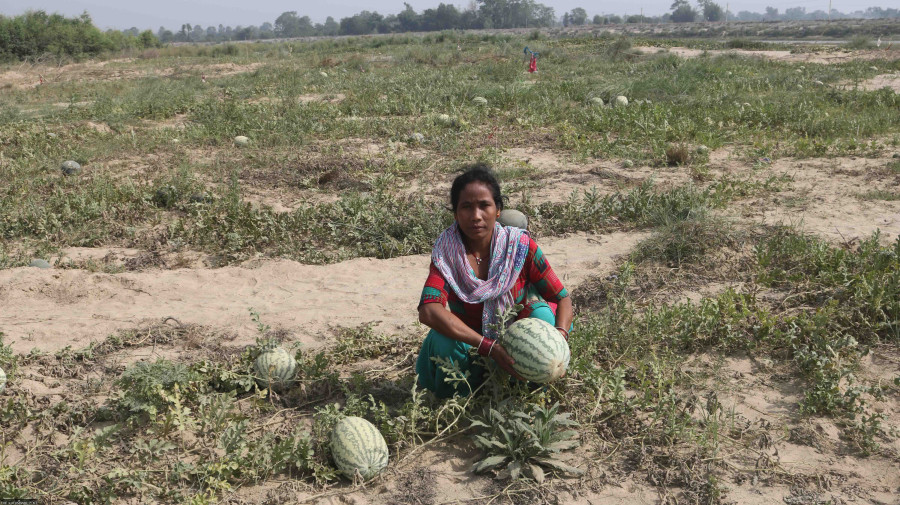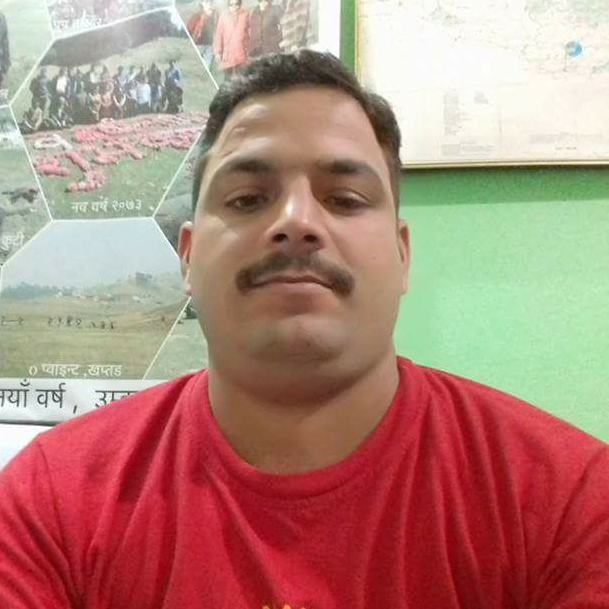Money
Farmers prosper by growing fruits on riverbanks
They have found out that they can grow crops with less manure and less water in the sandy soil on the banks of the Doda river.
Kamal Panthi & Bhawani Bhatta
The banks of the Doda river in Laljhadi Rural Municipality are dotted with thatched huts housing guards who watch over the fruits and vegetables flourishing on the once barren land.
Farmers had no use for the river banks that were covered sand and gravel, but now they have become important sources of income for them.
They have found out that they can grow crops with less manure and less water in the sandy soil. Several villagers have even built temporary dwellings on the river banks.
It’s summer and the river banks have turned green with watermelons. But the farmers are disheartened that they have to compete with cheap Indian imports that are flooding the market.
“We guard the crops during the night and during the day. These huts protect us from the sun,” said 70-year-old watermelon farmer Daan Singh Giri. He grows watermelon, gourd, bitter gourd, cucumber and pumpkin on his farm at the river's edge.
Daan Singh's son Mel Singh usually harvests the vegetables early in the morning and loads them on tractors for transport to nearby markets.
In 2007, the Doda river flooded and the family had to move. The flood waters also covered their 3-acre farm with sand and gravel.
Mel Singh became worried about his survival when he saw his farm destroyed. But the flood actually turned out to be a boon for him as he found out that fruits and vegetables grew well on his field.
More than 300 families are growing fruits and vegetables on the river banks, which have become a key source of income for them.
Customers come to the farms to buy vegetables like pumpkins and gourds. But farmers like Singh have a hard time selling their watermelons.
“Watermelons are imported from India and so the Nepali product does not get a good price,” said Mel Singh.
Watermelons sell for Rs30 per kg in the local market. Farmers get only Rs12 per kg from wholesale buyers.
When Singh supplied watermelons to a vegetable mart in Mahendranagar, he was offered only Rs7 per kg.
Around 50 stalls have been set up at either end of the Banhara Bridge in Kanchanpur where farmers display fruits and vegetables produced on the river banks.
“The cost of transporting fruits from Laljhadi to Mahendranagar is Rs4 per kg,’’ said Singh. Although the production cost of watermelon is not much, there are expenses like transportation which push up the cost.
“A few farmers sell watermelons on the highway,” he said.
Farmers get low prices for their fruits and vegetables from wholesalers, but they can make a handsome income by selling them to the customers directly.
“Last month, I sold watermelons worth Rs100,000 to the customers directly,” said Shiva Lal Rana, a local of Krishnapur-2.
“We don’t get fair prices selling our products to wholesalers. Therefore, we have set up our own stalls on the highway,” said farmer Sharada Rana.
Sharada’s husband works in Shimla, India and she has to look after the children by herself.
“The income from watermelons covers all my domestic expenses, including the school fees of my children,” added Rana.
Shree Daas Tharu of Gulariya lost 7 acres of land when the Babai River flooded three decades ago. He tried to grow various crops on his farm which was covered by sand.
Tharu is happy now because watermelon grows well on the sandy land. For the last seven months, starting from mid-November, he has been making a good earning which, according to him, helps to support his family.
The 74-year-old Tharu said he had not imagined that his sand-covered field would yield such a big income.
Aash Rani Tharu, 40, of Barbardiya-11 lost her 1.5-acre farm to the flood. Nowadays, she is making a good income from the same piece of land.
Farmers say that cultivation on the river banks is not feasible during the rainy season. Many farmers now grow fruits and vegetables on the river banks and take them to the highways to sell.
“We don’t have to face market problems for our products. We don’t have to look for buyers either,” said farmer Ram Naresh Ray of Indrapur.
Farmer Fuku Ram Tharu said he made more than Rs60,000 in the last three months by growing vegetables on the land he has leased near the river's edge.
“The money has helped me to pay the children’s school fees. I also make instalment payments of my home loan,” said Tharu.
According to him, local farmers are making up to Rs40,000 per kattha in a season by growing watermelons and vegetables.
In the last four decades, floods in the Babai River have turned more than 167 acres of farmland into wasteland.
“It’s not easy to farm on the banks of the river,” added Tharu.
According to the Agriculture Knowledge Centre in Kanchanpur, around 400 families in the district have been engaged in farming on 30 to 35 hectares of land on the river banks covered with sand and gravel.
The farmers plant the seeds in December-January and start harvesting in mid-March. It lasts till mid-June.
“The sandy soil on the river banks is suitable for growing climber and creeper plants,” said Hari Datta Joshi, an agricultural officer at the knowledge centre. “The cost of production is also low as they don’t need irrigation like for other plants.”
Farmers say that nearly 14 tonnes of fruits and vegetables can be produced on a hectare. They are sold to customers directly. Farmers also make bulk shipments to other districts in Sudurpaschim and Lumbini provinces.




 12.12°C Kathmandu
12.12°C Kathmandu
















